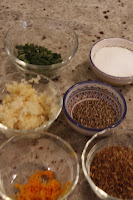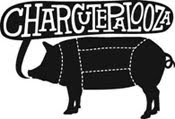As a young twenty-something, watching Julia Child’s The French Chef on Sunday evening was my introduction to fine cooking. I bought her cookbooks and picked a few favorites that became part of my repertoire. When My Life in France came out, I bought a hard-cover copy and was delighted to learn about how she became Julia Child, my mentor. About the same time, I also was delighted to read Julie Powell’s sweet book. The opening of the movie that combines the two stories required a special celebration.
I invited my close friends to a Julie and Julia potluck dinner. Everyone was asked to channel their inner Julia Child and produce a dish from one of her cookbooks – but preferably from Mastering the Art of French Cooking (MAFC). We planned to go to the Julie and Julia movie following the dinner. So on a perfect Saturday evening in Saratoga Springs, we set out on our dining and viewing adventure.
Everyone arrived around 4:30 to allow us time to eat and make a 7:30 movie time. The meal began with an aperitif of sparkling wine with cold blueberry soup. The cold blueberry soup was not a Julia recipe but one I got from Kim Suneé. I attended her cooking demo this summer at the Battenkill Kitchen. Everyone loved the combination and Kim’s recipe from her book, The Trail of Crumbs (kimsunee.com) is below:
Chilled Blueberry Soup
Add 1 or 2 teaspoons of this to a glass of champagne or prosecco for a sweet summer sparkler; use to top crepes, pancakes or ice cream; or serve for dessert in chilled espresso cups.
- 6 cups fresh blueberries, divided, or 2 (12 ounce) bags frozen blueberries
- 4 cloves
- ½ cup liquid honey
- 1 vanilla bean, scraped, or 1 cinnamon stick
- 1 Tb fresh lemon juice
- 3 Tb crème de cassis
- 1 Tb balsamic vinegar
- Garnish: lemon or orange zest, crème fraiche
Rinse blueberries and place all but 1 cup in a large pot. Add cloves and stir in honey. Split vanilla bean lengthwise, scrape seeds into pot using tip of knife, and add scraped bean halves (or scrape cinnamon into pot and add stick). Add 1 cup water and stir.
Bring to a boil, reduce heat and let simmer about 10 minutes. Strain, using back of spoon to crush berries, through a fine sieve into a bowl. Discard solids. Let soup cool. Stir in lemon juice, crème de cassis, and vinegar. Add more honey, as needed. Chill in refrigerator 4 hours and up to 2 days. Serve in chilled bowls with reserved 1 cup fresh blueberries. Garnish if desired. Makes 3 cups.
To accompany the aperitif, I made Julia’s Galettes au Fromage (p. 197 MAFC). Julia’s instructions wer e to test bake one because the amount of flour to use depended on the cheese used. Was she right! I used a softer cheese than the recipe and my first test just flattened out on the sheet. I added more flour and the second test was successful.
e to test bake one because the amount of flour to use depended on the cheese used. Was she right! I used a softer cheese than the recipe and my first test just flattened out on the sheet. I added more flour and the second test was successful.
Marjorie Martin made our first course of Vichyssoise (p. 39, MAFC). She bought new bowls for the party (she said it was one of the wonders of the  Dollar Store) and she garnished the soup beautifully with minced chives. Marjorie rated it a very easy recipe. We paired this part of the meal with Pouilly-Fuse. Throughout the meal Kay Olan provided a constant supply of beautiful baguettes from Mrs. London’s (she is not a cook and not apologetic about it)!
Dollar Store) and she garnished the soup beautifully with minced chives. Marjorie rated it a very easy recipe. We paired this part of the meal with Pouilly-Fuse. Throughout the meal Kay Olan provided a constant supply of beautiful baguettes from Mrs. London’s (she is not a cook and not apologetic about it)!
After the soup, we went to the main course. This was nearly overwhelming! We had a Salade Niçoise, Roast Chicken, Tomates a La Provençale and Timbale of Fresh Corn. We opened a bottle of Cotes du Rhone Rose to accompany.
 Jude Nordhoff made the Salade Niçoise ( p. 542, Mastering the Art of French Cooking). She was a little flustered by the recipe, said it took her much longer to make than anticipated and had to improvise the dressing because the cookbook referred her to a page she didn’t copy. What the matter, the results were spectacular.
Jude Nordhoff made the Salade Niçoise ( p. 542, Mastering the Art of French Cooking). She was a little flustered by the recipe, said it took her much longer to make than anticipated and had to improvise the dressing because the cookbook referred her to a page she didn’t copy. What the matter, the results were spectacular.

Nancy Luther made the Tomates a La Provencale (p. 507 MAFC). She minced the ingredients by hand (a la Julia) and said it took a lot more effort than she anticipated. Julia recommended that the tomatoes not be crowded in the dish and Nancy discovered that if they had been crowded they would have been difficult to serve. Gratefully, Nancy left me some tomatoes ready for heating today.
H olly Lawton came with the Timbale of Fresh Corn (p. 127, Julia Child & Company). It was delicious. I’m including the recipe because not many of my friends have the cookbook and Holly said she would make it again and again and again.
olly Lawton came with the Timbale of Fresh Corn (p. 127, Julia Child & Company). It was delicious. I’m including the recipe because not many of my friends have the cookbook and Holly said she would make it again and again and again.
Timbale of Fresh Corn
For an 8-cup baking dish, serving 8 people
- 12 or more ears fresh corn (to make about 3 cups grated corn)
- 6 eggs
- 2-3 Tb grated onion
- 1 tsp salt
- 4-5 Tb minced parsley
- 2/3 cup lightly pressed down crumbs, from crustless nonsweet white bread
- 2/3 cup lightly pressed down grated cheese (such as a mixture of Swiss and/or Cheddar or mozzarella)
- 2/3 cup heavy cream
- 1/8 tsp Cayenne pepper
- 8-10 grinds fresh pepper
Scrape or grate the corn and turn into a measure to be sure you have about 3 cups. Beat the eggs in a mixing bowl to blend; then add all the rest of the ingredients listed, including the corn.
Recipe may be completed even a day in advance to this point; covered and refrigerated.
Preheat oven to 350 degrees. About 2 hours before serving, butter the baking dish and line bottom with a round of buttered wax paper. Stir up the corn mixture to blend thoroughly and pour into the dish. Set corn dish in a bain-marie. Bake in lower-middle level of oven for half an hour, then turn the temperature down to 325 degrees. Baking time is around 1 ¼ to 1 ½ hours, and water surrounding the timbale should almost but never quite bubble; too high heat can make a custard grainy. Timbale is done when it has risen almost to fill the mold, the top has cracked open, and a skewer plunged down through the center comes out clean. Let rest 10 minutes or more in turned-off oven, door ajar, before unmolding.
May be baked an hour or so before serving; the timbale will sink down as it cools.
 My contribution was Roast Chicken (p. 240, MAFC) which was supposed to be a “perfect” roast chicken. It wasn’t perfect, but pretty good. A couple of problems with trussing (no trussing needle made inserting the string a little difficult) made it difficult to roast the chicken on its side. My solution was to roast it upside down. Also, I was less than diligent about basting, but did get in a several bastings. I reduced to pan juices to a sauce (burned my finger by grabbing the hot handle of the roasting pan on the stove) and poured it over the finished bird (which I cut up into serving pieces before it went to the table).
My contribution was Roast Chicken (p. 240, MAFC) which was supposed to be a “perfect” roast chicken. It wasn’t perfect, but pretty good. A couple of problems with trussing (no trussing needle made inserting the string a little difficult) made it difficult to roast the chicken on its side. My solution was to roast it upside down. Also, I was less than diligent about basting, but did get in a several bastings. I reduced to pan juices to a sauce (burned my finger by grabbing the hot handle of the roasting pan on the stove) and poured it over the finished bird (which I cut up into serving pieces before it went to the table).
By this time we were all really stuffed so we took a little pause before the cheese course. We soon started on the cheeses which included gorgonzola, Wensleydale with apricots and a creamy camembert.
Beverly Reedy brought dessert – Tarte au Citron et Aux Amandes (p. 646, MAFC). Let me tell you a little about Bev. She is a local chef – founded Beverly’s on Phila Street in Saratoga, currently owned by her son Michael Bowman, and author of the cookbook Beverly’s Best (http://beverlysbest.net). She also has a line of barbecue sauce, sweet relish and apple butter that is carried at the restaurant and other locations in the Northeast. Beverly bakes! She followed MAFC but said with her own recipes she could turn out the tart in about an hour. She had issues with Julia’s technique for candying the lemon rind and thought her own method is a lot better. The tart was fabulous and she served it with a berry puree sauce (blueberries, blackberries and raspberries). We also had some crème Fraîche to accompany the tart.
in the Northeast. Beverly bakes! She followed MAFC but said with her own recipes she could turn out the tart in about an hour. She had issues with Julia’s technique for candying the lemon rind and thought her own method is a lot better. The tart was fabulous and she served it with a berry puree sauce (blueberries, blackberries and raspberries). We also had some crème Fraîche to accompany the tart.
Okay, we missed the Julie and Julia movie because the dinner lasted four hours. No one felt stuffed by the end because we paced out the meal and did not rush. Guess the French have it right. It was a lovely meal with great friends. We’ll be getting together next week for the movie.

Kay & Jude

Holly & Marjorie

Marjorie & Kay

Beverly & Nancy



































